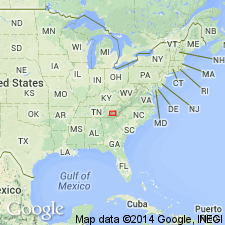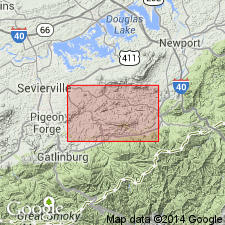
- Usage in publication:
-
- Yellow Breeches member*
- Modifications:
-
- Named
- Dominant lithology:
-
- Limestone
- Dolomite
- AAPG geologic province:
-
- Appalachian basin
Summary:
Named as a member of the Wilhite formation of the Walden Creek group of the Ocoee series. Named for Yellow Breeches Creek, east of Jones Cove. Consists of limestone and dolomite, sandy and conglomeratic in places, and interbedded with varied argillaceous, silty, and sandy rocks. Thickness is more than 100 ft. Overlies Dixon Mountain member of Wilhite. Age is later Precambrian.
Source: GNU records (USGS DDS-6; Reston GNULEX).

- Usage in publication:
-
- Yellow Breeches member*
- Modifications:
-
- Overview
- AAPG geologic province:
-
- Appalachian basin
Summary:
Yellow Breeches member of Wilhite formation is shown on map by unnamed lower unit of varied clastic and carbonate rocks and an unnamed upper unit of mostly limestone. Member is exposed in many places, especially between Short and Bearwallow Mountains; along Dunn Creek, Wilhite Creek, and Long Branch; and along Large Branch and Chavis Creek. Westernmost area of outcrop is a strip between Short and Bearwallow Mountains, widening northeastward toward Wilhite Creek; a wider area lies along Dunn Creek between Dixon Mountain and Chestnut Ridge; largest area lies east of Jones Cove. Upper limestone unit is about 500 ft thick; lower unit is about 1500 ft thick. Upper unit overlies lower unit at northwestern end of Pine Mountain. This member is unique among all other parts of Ocoee series because of its abundance of carbonates. Structure within member is complex, and may be more complex than just the division into an upper and lower unit. Age is late Precambrian. Report includes geologic map, cross sections, correlation chart, and measured sections.
Source: GNU records (USGS DDS-6; Reston GNULEX).
For more information, please contact Nancy Stamm, Geologic Names Committee Secretary.
Asterisk (*) indicates published by U.S. Geological Survey authors.
"No current usage" (†) implies that a name has been abandoned or has fallen into disuse. Former usage and, if known, replacement name given in parentheses ( ).
Slash (/) indicates name conflicts with nomenclatural guidelines (CSN, 1933; ACSN, 1961, 1970; NACSN, 1983, 2005, 2021). May be explained within brackets ([ ]).

